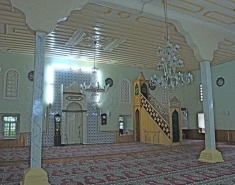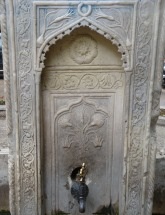“Long Bridge” Population: 4o,o00
Old names: Plotinopolis (Greek), Makra Gephyra, Cizr-i Ergene, Makrifere
Market day: Thursday
Festival: 18 November (City’s Independence Day)
In the very far west of Thracian Turkey, midway between Edirne and Keşan, Uzunköprü (Long Bridge) is named after its most conspicuous feature, a graceful Ottoman bridge on the Ergene river that was built between 1426 and 1443. The town has a large Roma population whose fine basketwork can sometimes be seen on sale at the local market.
At certain times of year the journey to Uzunköprü will give you plenty of opportunity to appreciate the never-ending fields of sunflowers (perversely called ayçiçek (moonflowers) in Turkish) that are a feature of southwestern Thrace. At other times the fields are flooded for the cultivation of rice (pirinç).
The bridge
The main reason to come to Uzunköprü is to see the bridge from which it took its name. This was commissioned by Murad II when the flooding of the Ergene river made it impossible for his army to press on towards Gallipoli. His first effort resulted in failure; the second took from 1427-43 to complete by which time a whole new own had grown up to support all the workers.
It would be great to say that the bridge is as much the highlight of a visit to Uzunköprü as Süleyman the Magnificent’s is to Büyükçekmece, However, even getting to look at it is complicated by the fact that it’s been turned into a busy modern road bridge. Alas, you can’t really see it from inside a bus. Nor can you see it very well from the town side of the bridge because one side is blocked by a military base while on the other the path rapidly runs out into fields.
Your best bet is to get out of the bus on the far side of the bridge where there’s a small car park. It’s just about possible to walk across it on a raised pavement but it’s narrow and not particularly safe.
The bridge in numbers
Length: 1,392 metres
Number of arches: 174
Years taken to build: 16
Opened: 1444
Around town
At the town end of the bridge stands the Özgürlük Anıtı (Freedom Monument) which dates back to 1908 when it was built to celebrate the restoration of constitutional monarchy. Its sides bear the upbeat words Hürriyet (Independence), Adalet (Justice), Müsavet (Equality) and Uhuvvet (Brotherhood).

Heading into town you’ll pass an Ottoman fountain across the road from the early 20th-century provincial library building. Keep walking straight ahead and you will come to the Muradiye Cami, built in 1443 as part of the development associated with the bridge and restored in 1621 when its dome was replaced with a flat roof. Of a medrese (theological school) and imaret (soup kitchen) that once formed a group with the mosque there is no longer any trace. It’s worth stepping inside to see the elegant painted wooden ceiling supported on two wooden columns.
Near the mosque is a small square with the pretty little Telli Çesmesi (Wired Fountain) in the centre. This four-sided fountain carved from single piece of solid marble dates back to the reign of Sultan Ahmed III and is decorated with carvings of carnations, roses and other flowers. The fountain was damaged during the Greek occupation (1920-22) but has been restored as faithfully as possible. Telli Çeşme
Telli Çeşme
In a side street off the square the early 20th-century Tekel Building has been converted into a Kent Müzesi (City Museum).
The Greek Orthodox Church of St John the Baptist was built in 1875 and has been restored to serve as a cultural centre.
The Market
Uzunköprü has a particularly lively market that fills two floors of a hall and flows out into the surrounding streets. After shopping the locals make their way back home in horse carts that line up waiting for hire at the edge of the action.
 The capacious Park Lokantası facing the market serves up an impressive array of lunch dishes to suit the stomachs of traders and shoppers alike.
The capacious Park Lokantası facing the market serves up an impressive array of lunch dishes to suit the stomachs of traders and shoppers alike.
As for ancient Plotinopolis, the remains so far discovered of a town dating back to the 2nd-century reign of the Emperor Trajan are over the border in Didymoteicho in Grecian Thrace.
Sleeping
You are unlikely to want to stay here but if you get stuck there are several hotel to suit a range of budgets.
Çakıcı Hotel. Tel: 0284-513 2121
Güneş Otel. Tel: 0284-518 1999
Shook Hotel. Tel: 0284-513 3435
Transport info
Most people visit Uzunköprü on a quick hop south from Edirne (55km).
For the time being the otogar is right beside the bridge and the market. Long may it last.
One train a day travels from İstanbul (Halkalı) to Edirne and vice versa, passing through Uzunköprü.

